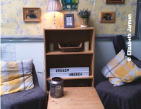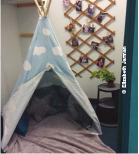Much attention is paid to the type of intervention we provide for children in school. However, less attention is given to where this intervention takes place and whether this can affect the outcomes.
Elizabeth Jarmen ProfileWe asked Elizabeth Jarman to tell us how she creates Communication Friendly Spaces™.
After many years of working at The Basic Skills Agency, it became increasingly apparent to me that where an intervention took place, was just as important as what it was and when it happened.
The whole environment inside and out needs to be inclusive, responsive and meaningful. All too often however, children who receive extra support do so in inappropriate places; working in busy corridors, squeezing into uncomfortable spaces, crouching in the corner of a classroom, none of which sets the scene to nurture effective communication and focus.
Shared communal spaces, the kind of places where you might be located with a child, are often ‘dumping grounds’ in schools. They regularly have no ownership and make ideal storage rather than learning spaces. They can become highways of noisy and distracting movement flow, often busily decorated and cluttered. In short. the last place you’d choose to connect and concentrate in.
If you have no choice other than to be in this space, consider making adaptations.
Here are two key areas within the Communication Friendly Spaces Approach TM which you could explore as a starting point for a whole school review.
Consider: What can be seen?
![]()
- Carry out an audit of the environment. Locate spaces which offer the best conditions for learning. Use the most communication friendly area possible and view the space from the child’s perspective.
- Reduce visual clutter. Review the number of posters, displays, brightly painted walls and hanging artwork. I’m not saying get rid of everything but create a space where the intended focus is clear and children are able to tune in rather than being visually distracted.
- Screening can block out these distractions. Think about creating temporary or flexible screening; blankets or sheets covering chairs as a simple screen or ceiling fixtures which allow you to drop down camouflage netting for example.
- Could an area could be decorated in plain, neutral colours; those you’d typically choose for your home . Calmer spaces can be created by using this colour palette.
- If you and the children can choose where you work together, ask them ‘Where would you like to go today?’ Allowing children to select the place that works best for them can transform engagement.
- Always have outside as an option; very often this is the most favoured environment for children and is typically less distracting.
- Think about outdoor seating that is comfortable for children and adults; position this carefully. Temporary pop-up structures work well outside and are quick to create and easy to store.
- If you have the budget, go for contained structures which are multi-purposed and weather proof. Great places to settle and talk.
- Of course, the learning environment does not have to be static and for many children this is hugely relevant in development terms. Combining communication interventions with movement is a great way of boosting concentration.

Consider: What can be heard?
![]()
Carry out a noise audit. Walk around your school on a typical day and tune in to sounds and noise levels. Each time you start work with a child, consciously alert yourself to the noise level and be aware of the impact it could have.
- Where are the quietest spaces in your environment? Maximise them.
- Noise levels may not be constant. Consider the timing of the session.
- Make sure that spaces that you create are not viewed as ‘places to perform’ for the children, but spaces that feel meaningful and connected. Personalise spaces with a basket of family photos maybe, images of past activities to trigger positive recall, magazines that feature the children’s fascinations and interests.
- Don’t try and replicate the classroom layout in hallways, corridors and cupboards; it may be that which negatively impacts on the child and their ability to relax into learning.
- Open and particularly hard surfaces bounce noise around, increasing its volume and capacity to disrupt. Soften you space with cushions, blankets, fleeces, bean bags, sofas and canopies to absorb noise and generally make the space more comfy.
- Define and make the intervention space smaller. For most, this can feel more secure.
- Make transportable spaces which can be set up in different places around your school, depending on the auditory challenge at that time. The same space could be set up countless times in different locations, offering familiarity and routine.

To find out more about the communication friendly spaces approach™ visit www.elizabethjarman.com
Inset Images courtesy of Willowtown Community Primary School, Ebbw Vale and Three Ways School, Bath.
Please login to view this content
Login